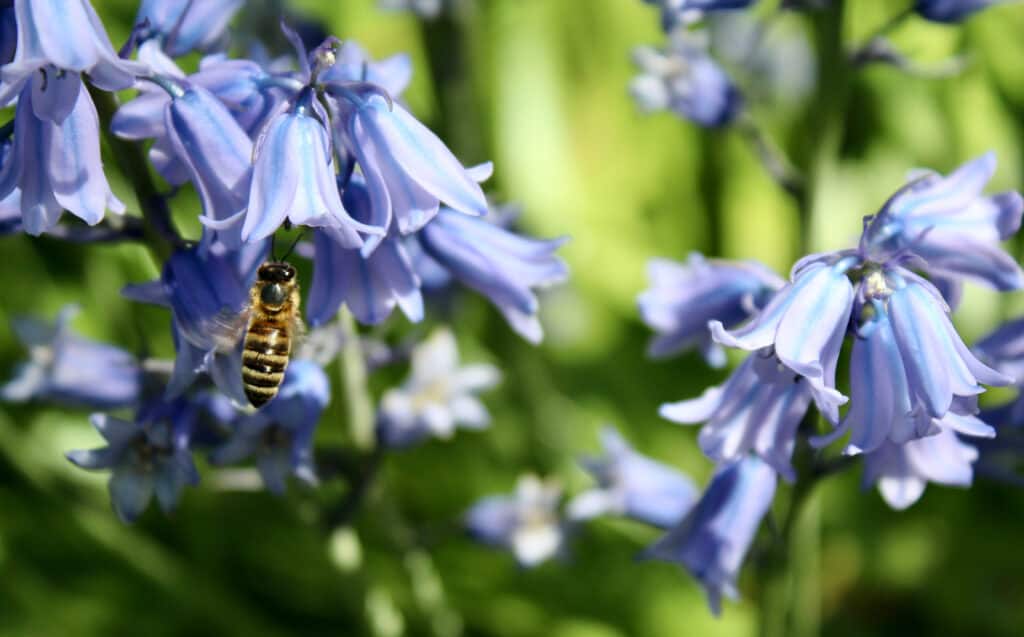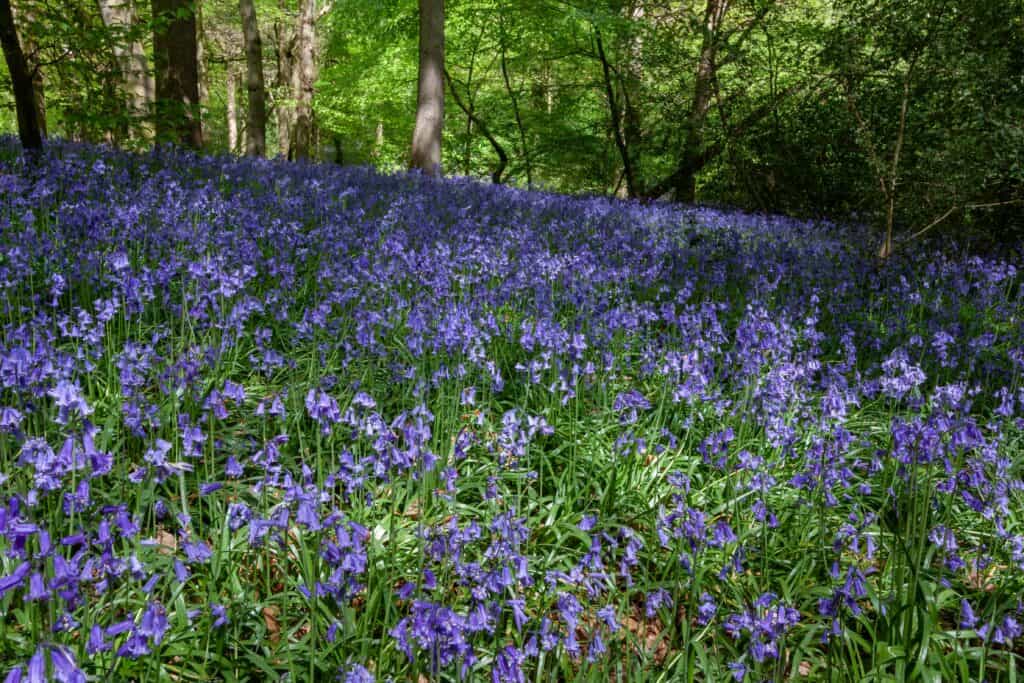Spanish bluebells are a great choice for your garden. They’re easy to grow, and they provide an amazing show of color. They are a little more delicate than English bluebells and have a more slender stem and delicate leaves. The Spanish bluebell’s flower is also smaller, with a darker shade of blue that’s almost violet in color.
English bluebells are a bit more hearty than their Spanish counterparts. They grow larger and stronger, with thicker stems and leaves that are often greenish-blue or grayish-blue in color. They also have a stronger scent than Spanish bluebells—a deep musky aroma that can fill your home with fragrance when they’re at their peak state of bloom.
While these two plants belong to the same genus, they have unique differences and similarities. Bluebells are one of the most popular spring flowers, and they have a wide variety of uses. This guide will explore what separates the Spanish bluebell from its English cousin, why you should grow them in your garden, and how to care for them.
Comparing Spanish Bluebells and English Bluebells
| Spanish Bluebells | English Bluebells | |
|---|---|---|
| Classification | Kingdom: Plantae Clade: Tracheophytes Clade: Angiosperms Clade: Monocots Order: Asparagales Family: Asparagaceae Subfamily: Scilloideae Genus: Hyacinthoides Species: H. hispanica | Kingdom: Plantae Clade: Tracheophytes Clade: Angiosperms Clade: Monocots Order: Asparagales Family: Asparagaceae Subfamily: Scilloideae Genus: Hyacinthoides Species: H. non-scripta |
| Origin | Spain, northwest Africa, Portugal, United Kingdom | North-western Spain, British-isles |
| Plant Type | Perennial, bulb | Perennial, bulb |
| Description | – 12-20 dangling, bell-shaped flowers – The flowers are lavender blue and ¾ inch long – 6-18 inches tall – 6-18 inches wide | – Trumpet-shaped blooms with six petals – Flowers are blue-velvet and 0.55-0.79 inches long – 3-6 linear leaves -12 inches tall – 4-8 inches wide |
| Uses | Ornamental flowers | Ornamental flowers |
| How to Grow | – Full sun in cool temperatures and partial shade in the summer. – Use well-draining sandy soil. – Keep soil moist, but avoid overwatering the plant. – Neutral, acidic, or alkaline soil pH. | – Do best in partial shade. – Use well-draining soil. – Keep soil moist. – Acidic, neutral, alkaline soil pH. |
Spanish Bluebells vs. English Bluebells: Classification and Origin
Spanish bluebell, Hyacinthoides hispanica, is native to the Iberian Peninsula and is now cultivated in Spain, northwest Africa, Portugal, and the United Kingdom. The Spanish bluebell is a common garden plant comprising various cultivars in shades of blue, pink, and white. They are bulbous perennials that bloom in the springtime.
English bluebells are in the same genus as Spanish bluebells but native throughout north-western Spain and British-isles. While it is widely grown as a garden plant, they grow in open areas in western regions, creating a blanket of blue flowers called “bluebell woods.”
Today, the bluebell gets hybridized, and this version invades the areas where native species grow. As a result, the common bluebell is now a threatened species. Insects and wind will carry the pollen from one bluebell species to another, resulting in a hybrid cross. Experts believe that the English bluebell characteristics are slowly getting lost, which can result in the species dying altogether.

Spanish bluebells (pictured) have no scent, unlike the English bluebell with a sweet smell.
©Svetlanko/Shutterstock.com
Spanish Bluebells vs. English Bluebells: Description
Do you know how some flowers just look like they’re glowing? Spanish bluebells are that flower. They’re a gorgeous, soft lavender blue and have a lovely shape. These delicate flowers tolerate shade well, so they will flourish when planted under trees or other shady areas on your property.
There are 12-20 dangling, bell-shaped flowers, approximately ¾ inches long, and hang from spikes. Each flower has between 2-6 strappy, linear leaves with a flower stem in the center. At its mature size, expect your Spanish bluebells to grow 6-18 inches tall and 6-18 inches wide.
Spanish bluebells have no scent. However, English bluebells emit a sweet and citrusy scent, and you can smell them before you see them. The scent is also the inspiration for many body creams and soaps. They have a unique color that is not quite the same as any other flower.
English bluebell blooms are trumpet-shaped with six petals that have up-turned lips. They are known for their lovely blue-violet color and soft petals, inspiring many to write poems about them. Each flower is approximately 0.55-0.79 inches long. There are 3-6 linear leaves that are about ½ inch wide. The plant is 12 inches tall and 4-8 inches wide when mature.
Spanish Blue Bells vs. English Blue Bells: Uses
Spanish and English bluebells are ornamental and planted among other bushes and trees to bring color and delicacy to a garden. They are beautiful when planted together in large groups but can also be grown individually for an elegant display in containers or hanging baskets. However, they can spread like weeds and requires care and attention to control their growth.
Bluebell species have cultural significance, and some think they cure nightmares in traditional medicine. In addition, many believe they are good diuretics or styptics. However, professionals in modern medicine disagree due to bluebells being toxic to humans and animals. Their sap is known to cause dermatitis, and they contain poisonous glycosides.

Both Spanish and English bluebells (pictured) thrive in shaded areas under forest trees.
©Philip Bird LRPS CPAGB/Shutterstock.com
Spanish Blue Bell vs. English Blue Bell: How to Grow
How to Grow Spanish Bluebells
Bluebells are one of the first flowers to bloom in spring, and they’re a welcome sight after a long, cold winter. They’re also easy to grow and can thrive in shady spots, making them the perfect addition to any garden. Plant your Spanish bluebells in the fall and watch these beauties bloom by the spring (April to early May). You can cut bluebell flowers and make flower arrangements without harming the plant.
Growing Spanish bluebell tips:
- Full sun in cool temperatures and partial shade in the summer.
- Use well-draining sandy soil.
- Keep soil moist, but avoid overwatering the plant.
- Neutral, acidic, or alkaline soil pH.
How to Grow English Bluebells
If you want to add color to your garden this spring and summer, look no further than English bluebells. They’re perfect for filling empty spaces and brightening up any garden area. They look especially beautiful when planted in clusters or masses with other spring flowers like pansies or daffodils!
Growing English bluebell tips:
- Do best in partial shade.
- Use well-draining soil.
- Keep soil moist.
- Acidic, neutral, alkaline soil pH.
Final Thoughts
Bluebells are a favorite among gardeners. They’re lovely, easy to grow, and make your garden look magical. But why should you grow bluebells?
Bluebells are a classic plant that you can use in many different ways around the house. They’re great for ground cover, but they also make wonderful additions to flower beds.
Spanish bluebells are beautiful, tall flowers with shiny, round leaves. They grow in clusters and are very common in Europe. English bluebell flowers have a more subtle color that often gets described as “muted” or “dusty.” However, these flowers are also more fragrant than Spanish bluebells, so if you’re looking for something that smells good and looks vibrant, English bluebell flowers may be better suited.
We love both species because they make excellent ground cover plants. They both grow well in partial shade and full sun, requiring little maintenance. In addition, they can be grown as perennials or annuals if you want to change up your garden’s look throughout the year.
The photo featured at the top of this post is © Andy119/Shutterstock.com
Sources
- Wikipedia, Available here: https://en.wikipedia.org/wiki/Hyacinthoides_hispanica
- Wikipedia, Available here: https://en.wikipedia.org/wiki/Hyacinthoides_non-scripta
- All Poetry, Available here: https://allpoetry.com/poem/8457985-The-Bluebell-by-Anne-Bront%C3%AB
- Kew, Available here: https://www.kew.org/plants/bluebell
FAQs (Frequently Asked Questions)
Do English and Spanish bluebells hybridize?
Spanish bluebell can spread like weeds and have the ability to hybridize. As a result, they can oust native bluebells threatening their species.
What can I plant with Spanish bluebells?
Spanish bluebells look excellent in a garden with lungwort and bleeding heart. They fit well in woodland gardens and thrive with other shade-loving plants, such as ferns and columbines.
Do Spanish bluebells have a scent?
Spanish bluebells have stunning blue velvet, delicate petals with no scent.
Can I plant bluebells under trees?
Bluebells grow best under deciduous trees that provide shade from the summer’s sun.
Thank you for reading! Have some feedback for us? Contact the AZ Animals editorial team.






